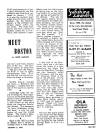
Home Page Meet Boston Menu Index
|
MEET BOSTON Friday, January 2, 1942 in What's New In Town W. J. Sidis |
The latest extension of territory acquired by the City of Boston was Hyde Park, annexed on January 1, 1912. It is also the farthest south within the city limits, and the southern tip, the Readville section, is the farthest out-of-town region within the city limits. The Hyde Park district was first a section of Dedham called the Lower Plains, then became a separate town, and finally became part of the city. The Fairmount section of Hyde Park―the part over the Neponset River―has no public transportation lines. But, just over the line into Milton, there are buses to Mattapan.
*
Norfolk County includes two towns―Brookline and Cohasset―isolated from the rest of the county by several miles.
*
Cambridge holds the record of being the most populous city of the most populous county of the Commonwealth. The county itself (Middlesex) is well known as the place where the American Revolution started. The expression “to every Middlesex village and farm” is only too well known all over the United States. The county’s population is about one million.
*
Back in the 1830’s as soon as Boston had a couple of railroad lines, a man named Adams went into the business of taking trips on the trains from Boston to various points with parcels entrusted to him for delivery. This was the first regular express service, which became the Adams Express Company, now part of the Railway Express system. (The name of the company may remind some old-timers of a joke current about 35 years ago, which ran: “Why was Eve created?” “For Adam’s express company.”) An assistant in Adams’ service, named Wells, during the 1840’s tangled with the government on account of delivering letters between Boston and New York cheaper than the post office. After this, Wells moved westward, and organized the Wells Fargo express system out there.
*
In the time of the Revolution, there was a mill-dam across the mouth of a cove separating the North End from the West End. This dam was also frequently called the Causeway, and the present Causeway Street is the top of the old dam. At the very earliest introduction of railroads, piers extending out from this dam became a favorite site for terminals of rail lines from the northwards, and, by 1893, no less than four such depots stood side by side on Causeway Street. It only required knocking down partitions to make North Station, which, till 1927, had all important features (Ticket offices, waiting rooms, washrooms, etc.) in triplicate.
*
The first free public school in the world was the Boston Latin School, started in 1636. It was originally on the site now occupied by the Suffolk Savings Bank in Scollay Square.